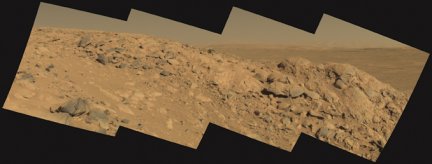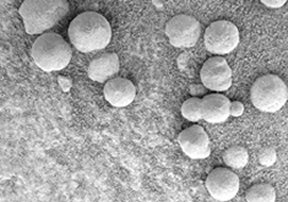Roving on the Red Planet
Robots tell a tale of once-wet Mars
When Phil Christensen was 13, his family moved from the flatlands of Kansas to the foothills of southern California. He soon began backpacking in the Sierra Nevada and Joshua Tree Park, marveling at the rocky desert landscape. Thirty years later, Christensen is exploring similar terrain on another planet.





He and his colleagues are in charge of miniature infrared spectrometers on the twin rovers that continue to explore Mars nearly 18 months after their arrival, gleaning information about rocks on the Red Planet much as field geologists learn about rocks on Earth.
Since January 2004, the rovers have been driving up hills and down into small craters, stopping along the way to grind or brush the surfaces of more than 100 rocks. Spirit arrived at Gusev crater on Jan. 3, 2004. Three weeks later, the lander bearing Opportunity touched down at the flatter Meridiani Planum near the Martian equator. Both rovers have now been exploring for more than five times their expected lifetimes. In late April, Opportunity got stuck to wheel-hub depth in a small dune but at press time was making inch-by-inch progress.
Christensen, who is based at Arizona State University in Tempe, and chief mission scientist Steve Squyres of Cornell University recently reviewed with Science News the mission highlights and what they reveal about liquid water on the Red Planet.
Anyone who caught the news as the rovers began beaming back what now amount to more than 80,000 images and 1.5 million spectra might have the impression that water flowed for eons on the now-frigid Martian surface. In fact, says Christensen, the rover data provide new evidence that “Mars has been cold and dry for most of its history.”
Liquid water might have been abundant on Mars, he says, but only for a brief period soon after the planet’s formation. Anyone who wanted to ride the rapids through Valles Marineris—Mars’ equivalent of the Grand Canyon—probably missed the boat by about 4 billion years.
Rolling along
Both landing sites were chosen from pictures taken by Mars-orbiting spacecraft. Gusev crater, a 160-km-wide, 1,600-meter-deep hole in the ground, had appeared to be a particularly promising place for finding landforms sculpted by flowing water. Recent observations by the Mars Global Surveyor spacecraft had indicated that the crater might have been part of an ancient lakebed. The crater even has a channel running into it.
Meridiani Planum, in contrast, seemed more intriguing for its chemical composition than for its geology. The region is rich in an iron oxide called grey hematite. On Earth, this rusty mineral usually forms when warm water flows through and dissolves iron-rich rock. But the overall shape of the region—a vast sheet of sand and gravel—didn’t seem to be sculpted by water.
Yet it was Meridiani Planum that grabbed the first headlines declaring that Mars had once been wet and warm enough to have flowing water.
By sheer luck, Opportunity had landed in one of the region’s few depressions, a 20-km-wide crater dubbed Eagle. In part of the crater wall, a curb-high ledge of exposed bedrock revealed the handiwork of liquid water.
Using the rover’s version of a magnifying glass, Opportunity found that the bedrock contains finely rippled layers stacked at odd angles to each other. The ripples are best explained by water flowing over and making waves in a sandy deposit, says Squyres.
Further evidence for water in Eagle crater came in the form of exotic, BB-size spheres of iron oxide. Some of these spheres, which rover scientists dubbed blueberries, were embedded in rocks, while others were scattered about, apparently liberated by a combination of wind and water erosion.
Squyres recalls the moment he first saw the blueberries. He was standing by a workstation at the rover’s command center, a blacked-out room in building 264 at NASA’s Jet Propulsion Laboratory in Pasadena, Calif. “These things came on the screen and I said, ‘Oh my God, look at them!'” he recalls. “At that instant, I realized how truly bizarre a place Meridiani was.”
At Eagle crater, Opportunity’s Mossbauer spectrometer, which is sensitive to iron-rich minerals, revealed that many rocks there contain iron-based salts in concentrations of 5 to 10 percent. Another instrument, the alpha-ray spectrometer, which can detect a much larger array of salts, found that the rocks were five times saltier than that. The high salt content, along with the blueberries, indicated that circulating water had percolated through the rocks, leaving behind the residues and the iron oxide blueberries.
“This extends the period of time when Mars had a wet environment,” says Christensen. Rocky sediments indicate only that standing water existed for perhaps as little as a few hundred years before evaporating. But salt deposits require water to percolate through rocks for millions of years, Christensen says.
Even millions of years is a short time in the history of the planet. Spirit’s close-up study of two very different groups of rocks at Gusev crater bolsters the scenario that Mars was wet and warm for only a relatively brief, early period.
In the area right around the landing site, Spirit found a collection of dry, dusty, volcanic rocks, each about 20 centimeters across. Randomly strewn about, they bore no visible sign of having interacted with water. Moreover, the rover found that the rocks contain an abundance of the mineral olivine, which easily dissolves in and can be washed away by water, just as dried sea salt rinses away in rain. The presence of olivine strongly suggests that water hadn’t flowed at Gusev crater for several billion years. Studying rock after rock, Spirit came up dry.
Then, the mission changed dramatically. About 6 months after landing, Spirit reached the top of an outcrop of old rocks called Columbia Hills. “The backpacker in me just wanted to get to the summit and look around,” says Christensen.
At the crest of a promontory known as the West Spur, about 9 meters above the surrounding Martian plains, Spirit discovered a kind of rock that it had never before encountered. The rocks there told a much wetter story than had any of Spirit’s other investigations. The softness of the rocks, the relative absence of olivine, and the elevated concentrations of chlorine, bromine, and sulfur—materials that are readily deposited by liquids—suggest that small amounts of water had coursed through the material.
Nearly every rock at Columbia Hills “looked like it had been drenched with water,” says Squyres. “It was like a whole new mission had come about.”
What could explain the difference between the rocks at Columbia Hills and those at the bottom of Gusev crater? Timing appears to be everything. Rough estimates, based on the pockmarks on their surface, put the hills at about 4 billion years old. That’s a half billion years or so older than the rocks Spirit examined at its landing site.
“It’s like somebody turned off the heat” so that the liquid water either froze or evaporated, says Squyres. “There was this warm, wet, juicy environment for maybe half-a-billion years. Then, the fun was over.”
Such a quick splash for Mars may seem at odds with the planet’s myriad water-sculpted features, such as channels and what appear to be dried-up riverbeds that spacecraft have spied since the early 1970s. These observations led both the public and planetary scientists to envision global oceans on the Red Planet that might have persisted for millions or billions of years. In fact, says Christensen, a catastrophic flood could have carved the channels in only a few hundred years, after which the water froze, evaporated, or went underground.
In this emerging view of Mars, the planet had one or more early pulses of water that at least in some areas were both highly salty and acidic. After perhaps half-a-billion years, the climate turned cold and dry and, it hasn’t changed since. The only water remaining on the surface of Mars is in the form of ice, mostly at the poles.
Even with liquid water available for only a few million years, life still could have gotten a foothold on ancient Mars, notes Squyres. But it would have had to quickly burrow deep into or in the vicinity of underground springs or other aquifers—any of which could still exist today.
Touchdown
Parachuting into a crater wasn’t Opportunity’s only good fortune. Last February, while investigating the remains of the heat shield that it had discarded after landing, the rover came upon a strange, shiny object. The vehicle’s infrared spectrometer revealed a pattern of light so similar to the Martian atmosphere that Christensen’s team at first thought the spectrometer was looking skyward rather than at the ground.
In fact, the basketball-size object found by the rover is a meteorite so reflective that it was bouncing light from the sky into the spectrometer (SN: 2/19/05, p. 124: Available to subscribers at Meteorite on Mars). Made primarily of iron and nickel, the meteorite probably came from an asteroid or a chunk of a rocky planet. Scientists are examining the meteorite to learn whether this area of the Martian surface is eroding or building up sand and soil.
For Christensen, another high point of the mission came just a few months after the rovers landed. For the previous 8 years, a thermal infrared spectrometer built by his team had flown around Mars aboard the Mars Odyssey spacecraft, monitoring the atmosphere from an altitude of 60 km.
Last year, the infrared spectrometers from Spirit looked up and met the gaze of the infrared spectrometer looking down from the orbiting Odyssey. For the first time, scientists had a detailed profile of the temperature and density of an entire column of Martian atmosphere, all the way from the planet’s surface to space. “It was an incredibly satisfying moment,” says Christensen.
The measurements showed that estimates of the composition of the Martian surface and lower atmosphere that scientists had been making from orbital observations were reliable.
For the future, mission scientists say they hope that Opportunity will last long enough to reach Victoria crater, 5 km from the rover’s landing site. Because it exposes layers of ancient rock 40 km deep, the crater could enable the rover to probe even further back into the history of water on the Martian surface. Getting to the crater, however, will require “3 km of difficult driving on a landscape no human eye has ever seen,” says Squyres.
“We’ve got some tough going ahead of us, and I have no idea whether we’re going to make it or not,” he notes.
In the meantime, Spirit is tackling its own tough terrain, climbing a rocky slope of Husband Hill in the Columbia Hills group. Rather than sliding into old age, the rover in some ways has grown younger: In March, after strong winds cleaned its dusty solar panels, the rover doubled its daily energy production to 900 watt-hours, a level it hadn’t attained since the mission was 30 days old.
Still, both rovers have shown signs of aging, including slipping wheels and balky brakes, cautions Squyres. Even if both rovers died tomorrow, he says, “it’s been the adventure of a lifetime.”







